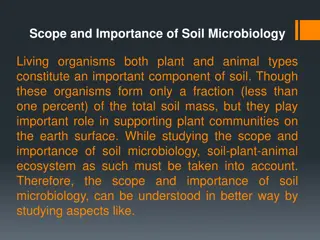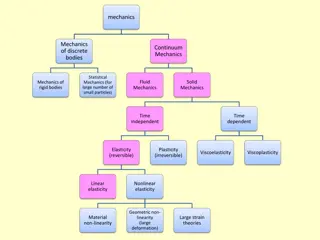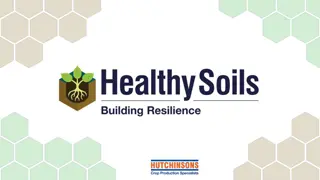Construction Safety and Soil Mechanics Overview
This content provides valuable information on excavation, trenching, soil mechanics, OSHA regulations, common violations in construction and excavation, fatal incidents, soil composition, and soil weight calculations. It emphasizes the importance of following safety protocols in construction work related to excavations, highlighting the risks and consequences of non-compliance with regulations. The data presented sheds light on the significance of understanding soil behavior and implementing protective measures to prevent accidents and ensure worker safety.
Download Presentation

Please find below an Image/Link to download the presentation.
The content on the website is provided AS IS for your information and personal use only. It may not be sold, licensed, or shared on other websites without obtaining consent from the author. Download presentation by click this link. If you encounter any issues during the download, it is possible that the publisher has removed the file from their server.
E N D
Presentation Transcript
Excavation, Trenching, and Soil Mechanics
OSHA Regulations 1926.650: Scope and Application 1926.651: Specific Excavation Requirements 1926.652: Requirements for Protective Systems 1926 Subpart P Appendix A: Soil Classification Other Appendix and Tabulated Data
Most Frequently Cited Serious Violations in Construction FY 2020
Most Frequently Cited Serious Violations in Excavation FY 2020
Scope and Application This subpart applies to all open excavations made in the earth s surface. Excavations are defined to include trenches. 1926.650
Fatal Facts An employee was installing a small diameter pipe in a trench 3 wide, 12-15 deep and 90 feet long. The trench was not sloped or shored nor was there a box or shield to protect the employee. Further, there was evidence of a previous cave-in. The employee apparently reentered the trench, and a second cave-in occurred, burying him. He was found face down in the bottom of the trench.
Fatal Facts Four employees of a mechanical contractor were laying a lateral sewer line at a building site. The foreman, a plumber by trade, and a laborer were laying an eight- inch, 20-foot-long plastic sewer pipe in the bottom of a trench 36 inches wide, nine feet deep, and approximately 50 feet long. The trench was neither sloped nor shored, and there was water entering it along a shale seam near the bottom. The west side of the trench caved in near the bottom, burying one employee to his chest and completely covering the other. Rescue operations took two and five hours - too late to save the men.
What is Soil? A soil is a mixture of rock, water, air and a variety of other substances. Soil is made up of rock in the form of small particles and spaces called voids. Normally some part of these voids is filled with water.
Weighing in on Soil Solid Rock weighs about 167 lbs. Per cubic foot. Since a cubic foot of soil is about rock it will weigh about 83 lbs. Add in water and the weight begins to rise to around 114 lbs. (if saturated). Do the math and a simple cubic yard of soil can weigh over 3000 lbs! That is a ton and a !
Protecting Employees 1926.652 (a)(1) Each employee in an excavation shall be protected from cave-ins by an adequate protective system designed in accordance with paragraph (b) or (c) of this section except when: (i) Excavations are made in entirely stable rock; or (ii) Excavations are less than 5 in depth and examination of the ground by a competent person provides no indication of a potential cave-in.
Protective Systems a method of protecting employees from cave- ins, from material that could fall or roll from an excavation face or into an excavation, or from the collapse of adjacent structures. Protective systems include support systems, sloping and benching systems, shield systems, and other systems that provide the necessary protection
Options for Protection Use a Registered Professional Engineer to design a sloping or benching system. Use support systems in accordance with requirements set forth in the standard. Purchase an engineered system, (example..a trench box or shield.) Have a PE design a shielding or shoring system specific to your task.
Protective Reqiurements 29 CFR 1926.652(b)(4)(i) Design by a registered professional engineer. Any system not found within the guidelines set forth in the standard, or within the tabulated data tables in the standard requires use of a Professional Engineer. No where in the standard or tabulated data does it allow for excavations deeper than 20 feet.
Knowledgeable Employee One who is capable of identifying existing and predictable hazards in the surroundings, or working conditions which are unsanitary, hazardous, or dangerous to employees, and who has the authorization to take prompt corrective measures to eliminate them
Inspections Daily Inspection of excavations shall be conducted by a competent person prior to the start of work and as needed throughout the shift. 1926.651(k)(1) Inspections shall also be conducted after every rainstorm or other hazard increasing occurrence.
Access and Egress 1926.651 (c)(2) A stairway, ladder, ramp or other safe means of egress shall be located in a trench excavations that are 4 or more in depth so as to require no more than 25 of lateral travel for employees.
Soil Tests 1926 Subpart P Appendix A, Soil Classification (c)(3) In order to classify a soil A, B, or C at least one visual and one manual test must be performed by a competent person.
Visual Test Visual analysis is conducted to determine the qualitative information regarding the excavation site in general, the soil adjacent to the excavation, the soil forming the sides of the open excavation, and the soil taken as samples from the excavated materials.
Manual Tests Manual analysis of soil samples is conducted to determine quantitative as well as qualitative properties of soil to provide more information in order to classify soil properly. Examples: Thumb penetration, Pocket penetrometers, Drying tests, Sedimentation
Thumb Test 1926 Subpart P Appendix A(2)(iii) Type A soils with an unconfined compressive strength of 1.5 tsf can be readily indented by the thumb; however, they can only be penetrated by the thumb only with great effort Type C soils with an unconfined compressive strength of .5 tsf can be easily penetrated several inches by the thumb and can be molded by light finger pressure.
Solid Rock Natural solid mineral matter that can be excavated with vertical sides and remain intact while exposed
Type A Soil Cohesive soil with an unconfined, compressive strength of 1.5 Tsf. Examples of this type of soil are: Clays Silty clay Sandy clays Clay loam.
Soil is NOT Type A if: The material is subject to other factors that would require it to be classified as a less stable material. The soil has been previously disturbed. The soil is subject to vibration. The soil is fissured. Water is present.
Sources of Vibration Traffic Railroad Operations Heavy Equipment Operations Jack Hammer Operations Tamping Machine Operations Thumping Car Stereos that make you want to pull your hair out and to never mind
Type B Soil Cohesive soil with an unconfined compressive strength greater than .5 Tsf Granular cohesionless soils including; silt, silt loam, sandy loam, and some sandy clay loam Previously disturbed soils except those which would otherwise be classified as Type C soil
Type C Soil Cohesive soils with an unconfined compressive strength of 0.5 Tsf or less Granular soils including gravel, sand, and loamy sand Submerged soil, or soil from which water is freely seeping
Soil Requirments by Slope Type Maximum Allowable Slope for Excavations less than 20 Vertical (90 Deg.) Soil or Rock Type Stable Rock Type A to 1 (53 Deg.) Type B 1 to 1 (45 Deg.) Type C 1 to 1 (34 Deg.)
Trench Boxes or Shield Systems A structure that is able to withstand the forces imposed on it by a cave-in and thereby protect employees. Trench boxes are generally used in open areas, but they may also be used in combination with sloping and benching. The box should extend at least 18 inches above the surrounding area if there is sloping toward the excavation.
Is this Allowable? YES! If the Trench boxes are designed to be stacked and are used in accordance with their tabulated data.
Shoring Systems A structure such as metal hydraulic, mechanical or timber shoring system that supports the sides of an excavation and which is designed to prevent cave-ins.
Surface Encumbrances 1926.651 (a) All surface encumbrances that are located so as to create a hazard to employees shall be removed or supported as necessary to safeguard employees Adjacent Structures Roads and/ or Sidewalks Mailboxes Curb and Gutter Utilities Light poles
Utilities 1926.651(b) The estimated location of utility installations, such as sewer, telephone, fuel, electric, that reasonably may be expected to be encountered during excavation work, shall be determined prior to opening an excavation
Can an Excavation be a Confined Space ? Oxygen deficient atmospheres: less than 19.5% oxygen Potential for other gases to be present include but not be limited to: Natural Gas from potential leaks or cut lines. Methane from decayed matter.
Summary Call before you dig. Use at least one visual and one manual soil test to determine soil type. A ladder is required for access and egress at 4 . The ladder must be within 25 lateral travel at all times. At 5 depth some type of protective system is required . Treat all soil as Type C and slope at 1 : 1 and you are covered. If not: Use some type of shoring or shielding to protect your employees. Excavations over 20 require the use of a P.E.

























